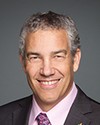Thank you.
I'm trying to understand something about coverage and what we are and are not getting done. My riding is in Montreal. When this was first brought to my attention, I didn't know there was an issue, because I don't have any rural constituents.
When I first looked into it, I got maps, such as the one presented here that we're looking at, which says, for example, that 99% of households are covered at 1.5 megabits and 96% are at 5 megabits. I said, “Well, it seems to me that we have pretty much most of the heavy lifting done.” It's a very small part—4%—of our huge country that has to be done. Then, every time I spoke to members of my caucus who were in rural ridings, they were up in arms about the lack of service, so there's a dichotomy here.
There's a dichotomy in the numbers I'm seeing and what I hear from my colleagues, and in fact even in your statements. I'd like to point it out, and I'd like to try to understand it.
For example, Mr. Seidl, you said in your testimony that in 2011 your objective rates were 10 times less. You have 50-megabit rates now, which is your goal, so 10 times less is 5 megabits. In 2011, 5 megabits was your goal, and I look at that here, and we have 96% done, so it's actually pretty good.
However, when I look at the questions and what I hear through the testimony.... You gave the example of Renfrew. Renfrew is 100 kilometres from our nation's capital. It's not a small town. It's 8,000 people plus, and you're giving that as a great example of how we were able to help Renfrew. Well, it doesn't add up to saying that 96% of the country is covered if we're giving an example of a decent-sized town 100 kilometres from our nation's capital and saying to look at what we have been able to do for them. There's something wrong there.
Also, then I hear that we have 900 applications asking for $4.4 billion in our latest program. Well, again, if we have 96% covered, where's that demand coming from? I hear that the CRTC wants to put in a $750-million fund, and you're hoping to leverage that to get a heck of a lot more out of it. Where I'm struggling with here is to understand these numbers I'm given here and what's clearly not in line with what I'm hearing from my colleagues and even in your examples.
Finally—and I'll start with you, Mr. Seidl—you said in your testimony that for approximately 18% of households service is out of reach. Again, I don't see the 18% here. The only place that has 18% is that 82% have 50 megabits. Is that what you are referring to?




